St. John’s Wort oil (Oleum Hyperici) has been a treasured remedy for centuries. Healers have turned to it for burns, scrapes, scars, stretch marks, and sun-damaged skin. It’s equally valued for easing sore muscles, soothing nerve pain, and melting away tension in the body. In folk medicine, it’s been trusted to lift low spirits, calm inflammation, ease hemorrhoids and sciatica, and bring relief to tired, heavy legs.
This guide covers everything you need to know about St. John’s Wort oil—its many uses, how to recognize the plant, when and where to harvest it, and step-by-step instructions for making your own infused oil at home. This ruby-red remedy is a must-have for any natural first aid kit and a beautiful way to preserve the magic hidden in its golden flowers.
Historical uses of St. John’s Wort
Across most of Europe, St. John’s Wort (Hypericum perforatum) bursts into bloom around the summer solstice, when the days are at their longest. This lines up with the feast of St. John the Baptist, a major festival in the Christian calendar. People believed the plant absorbed the sun’s peak energy, endowing it with powerful healing and protective qualities. The word “wort” is an old English term that means “medicinal herb.”
St. John’s Wort has a long history as a “magical” herb. People once believed it could chase away storms, lightning, witches, werewolves, and even evil spells. On St. John’s Eve (June 24), the plant was blessed and hung under the eaves of houses and barns to protect families and animals from harm. The ruby-red oil made from its flowers was said to symbolize the blood of St. John the Baptist.
In Herzegovina and Dalmatia, people would plant St. John’s Wort in their gardens, vineyards, and orchards, believing it would bless them with a rich harvest. Even today, some still hold to the old tradition of tucking a sprig of the herb under their pillow on the night before St. John’s Day. They say the saint will visit you in your dreams, offer his blessing, and guard you from harm or misfortune for the year to come.
During battles and uprisings, warriors often carried pieces of St. John’s Wort sewn into leather as a charm against knives, bullets, and bad luck. Across many cultures, this “sun plant” became a powerful symbol of protection and the ability to drive away anything harmful.

The exceptional healing powers of St. John’s Wort were first noted in Natural History by Pliny the Elder (23–79 CE). He believed the plant held the energy of the sun, making it especially helpful for lifting melancholy and easing fears that creep in at night. Pliny praised it as a remedy for wounds, burns, and nerve pain, noting it was particularly effective for “deep injuries and damage to the nerves.”
In De Materia Medica, Dioscorides (40–90 CE) recommended Hypericum for its ability to heal wounds, burns, and soothe sciatica. He described steeping the plant in oil—an early version of the St. John’s Wort oil we know today—and using it on the skin to treat cuts, ulcers, and even snake bites.
Paracelsus, the 16th-century Swiss physician and alchemist, held Hypericum perforatum in high regard. He called it the “arnica of the nerves,” for its ability to calm nerve pain, sciatica, and neuralgia. Besides that, he recommended St. John’s Wort for melancholy, depression, and nervous overstimulation; he used it for blood cleansing, care of wounds, cuts, muscle cramps and snake bites.
Soon after, healers across Europe began relying on St. John’s Wort for all sorts of ailments. They used it to treat burns and wounds, ease cramps and aches, clear phlegm, and calm nerve troubles. It became a go-to remedy for sore muscles, bruises, boils, ulcers, swelling, and more. The deep red oil pressed from its flowers was especially valued for cleansing and softening the skin—gently removing dead cells, healing cracks and dryness, and restoring a youthful glow. They used the oil to soothe varicose veins and sunburn.
Moreover, St. John’s Wort oil was also praised as a remedy for easing constipation, expelling intestinal worms, and relieving lumbago, gout, rheumatism, and stubborn back pain. Healers used it to calm stomachaches, soothe inflamed intestines and colic, ease bladder issues such as incontinence, and help loosen stubborn phlegm in the lungs.
Like European herbalists, the Cherokee indians also held this plant in high regard. For snakebites, they would chew the root, swallowing a little to work the poison from within, then bind the rest over the wound to draw it out. A strong decoction was taken to break fevers and ease the bloody flux, while babies were bathed in a gentle root tea to lend them strength and vigor.
To stop a nosebleed, they would sniff the crushed leaves, while the plant’s milky sap was rubbed into sores to speed healing. Women drank it as a tea with skullcap and squaw vine to induce their menstrual flow. It was also used to ease bowel troubles, expel worms, and cleanse the body of venereal infections.
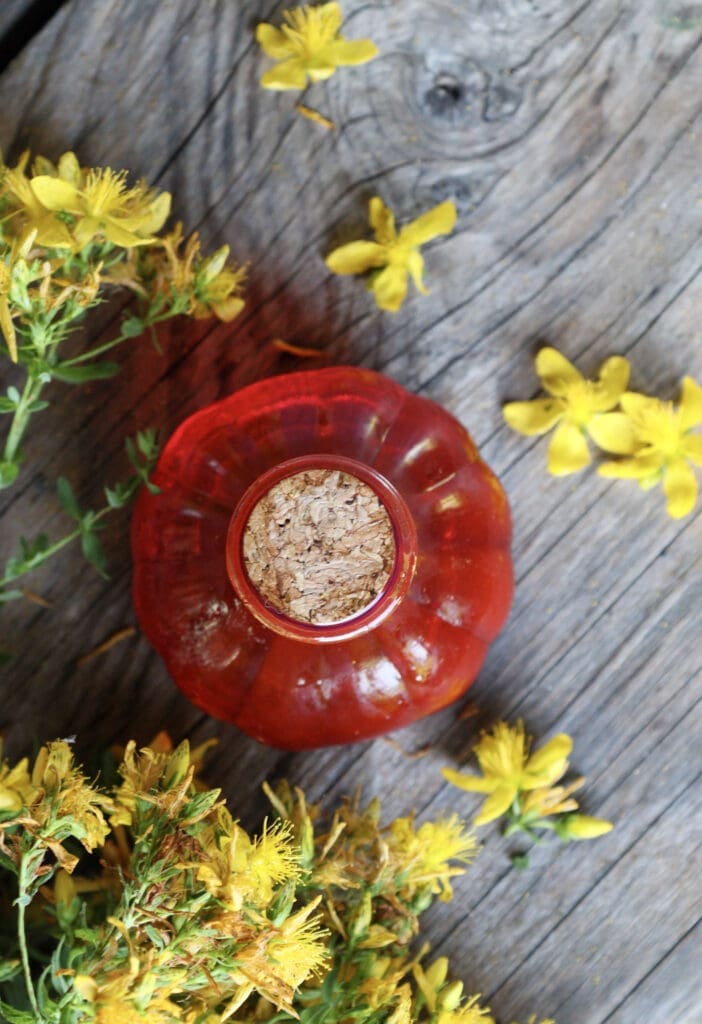
Benefits of St. John’s Wort infused oil
ANTIMICROBIAL ACTIVITY
St. John’s Wort (Hypericum perforatum) has long been valued to heal wounds and fight infections—and modern science now confirms why. Key compounds like hypericin and hyperforin are potent against bacteria, even stubborn strains like MRSA. Late-summer harvests produce the strongest oils, and fat-based infusions tend to be more effective than water-based ones.
antioxidative properties
St. John’s wort extracts are rich in flavonoids and polyphenols—natural antioxidants that help protect cells from damage. They fight oxidative stress, prevent lipid breakdown in cell membranes, and even shield the skin from UV damage without causing irritation.
anti-inflammatory powers
St. John’s Wort fights inflammation on many fronts. Its key compound, hyperforin, helps quiet the body’s fire by blocking enzymes that spark swelling and pain. It also calms overactive immune cells and supports tissue repair. Besides soothing sciatica or fibromyalgia, hypericin also eases immune reactions that drive chronic inflammation.
wound healing properties
St. John’s Wort (Hypericum perforatum) has been a go-to wound healing plant for long centuries. People have used it on cuts, burns, scrapes, ulcers, and all kinds of inflamed skin troubles. Its magic comes from a mix of antimicrobial and anti-inflammatory properties. Hyperforin actually kickstarts tissue repair and helps skin cells regenerate. It’s also been found to calm overactive immune cells in the skin. Research shows that it can speed up healing, including eczema, surgical wounds (like C-sections), bedsores, and even stubborn leg ulcers that are slow to close.
Neuroprotective activity
St. John’s Wort isn’t just for skin—it supports the nervous system, too. Herbalists have long used it to calm irritated nerves and alleviate pain associated with conditions such as sciatica and neuropathy. Research shows that Hypericum perforatum reduces neuropatic pain and can reduce inflammation in nerve tissue, and works effectively for nerve regeneration. It acts like a natural shield for your nerves, helping restore their healthy function.
antiviral and antifungal activity
Besides all the above, St. John’s Wort infused oil is also known for fighting off tough viruses and fungi. Traditional healers used it to ease cold sores and soothe shingles. For fungal issues like athlete’s foot, ringworm, and yeast infections, the oil has been applied to calm irritation and promote healing. You can use it as a massage oil, a salve, or even add it to a warm bath for full-body relief.
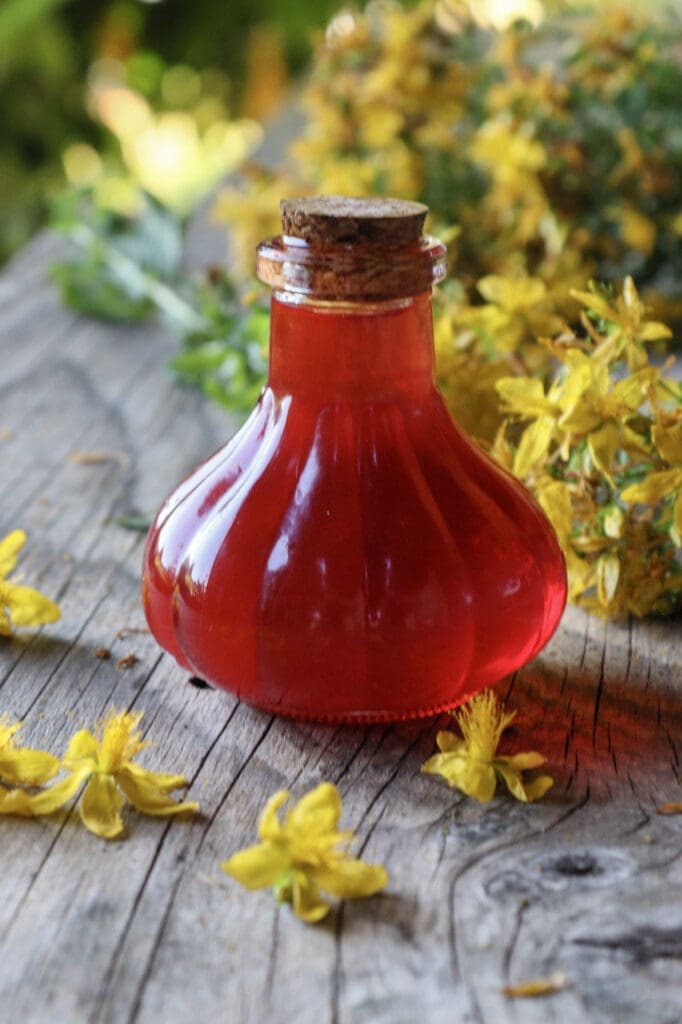
What you’ll need to make St. John’s Wort oil
- Hand-picked St. John’s Wort fresh flowers
- Carrier oil – cold-pressed organic olive oil works great
- A glass jar with a lid
- A strainer, clean gauze or cheesecloth
- Dark glass storage bottles
- Beeswax, if you want to process the oil further into a healing salve
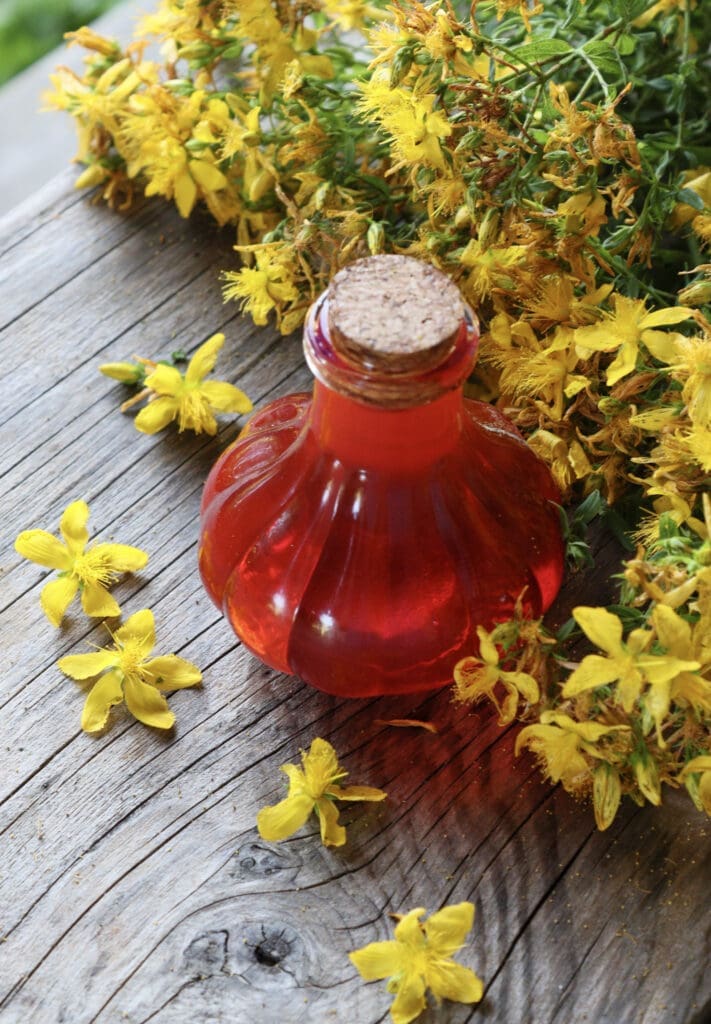
Harvesting St. Johns Wort flowers
St. John’s Wort originally comes from Europe and Siberia but has spread across the world, thriving anywhere the climate is mild enough for its growth. In the wild, you’ll often spot it along roadsides, trails, meadow edges, and open clearings. It grows in forests, fields, rocky soils, and even in poor, dry ground. You might see it near rivers and streams, or less ideal spots like along asphalt roads and stony paths. Each plant can produce up to 10,000 seeds, which is why it spreads so fast and takes hold almost anywhere.
St. John’s Wort blooms in bright yellow clusters at the tops of its stems. Each flower with five petals is sprinkled with tiny black or deep red dots along the edges. If you gently crush the buds between your fingers, they release a vivid red juice. The leaves appear to have tiny holes as well, but these are actually translucent oil glands that glow when held up to the light. In Europe, the plant usually flowers around the summer solstice, when the sun is strongest and the healing energy of its golden blooms is at its peak.
For making St. John’s Wort oil, always gather fresh, healthy-looking flowers. While dried flowers still hold some healing power, the hypericin—the plant’s key active compound—is far more potent in fresh blooms.
Choose a bright, sunny day when the plants are dry and at their flowering peak. Look for vibrant, healthy blooms and avoid areas near busy roads or polluted spots. Harvest responsibly—take only what you need. We like to bring home whole stems, using half for making oil and drying the rest for tea.
Also, never strip all the flowers from a single plant. You’ll often see dried blooms mixed with fresh ones—leave some behind so the plant can keep thriving. The most potent blossoms grow on the top of the stem, and those are the ones you’ll want to gather.
Keep the flowers in a paper bag or foraging basket and use them for oil as soon as you can—ideally the same day. The active components in the oil are at their strongest in fresh blooms, and once they dry, a lot of that potency fades.

How to make St. John’s Wort infused oil
There are several ways to make an infusion, but we prefer the traditional solar method—it works beautifully for St. John’s Wort. We used homemade, organic cold-pressed olive oil to soak the fresh flowers.
STEP 1: Pick your St. John’s Wort flowers and place them in a shallow bowl or plate to inspect for bugs. If you spot any, gently remove them by hand or set the bowl in a sunny, warm spot for about 30 minutes—most insects will leave on their own to escape the heat.
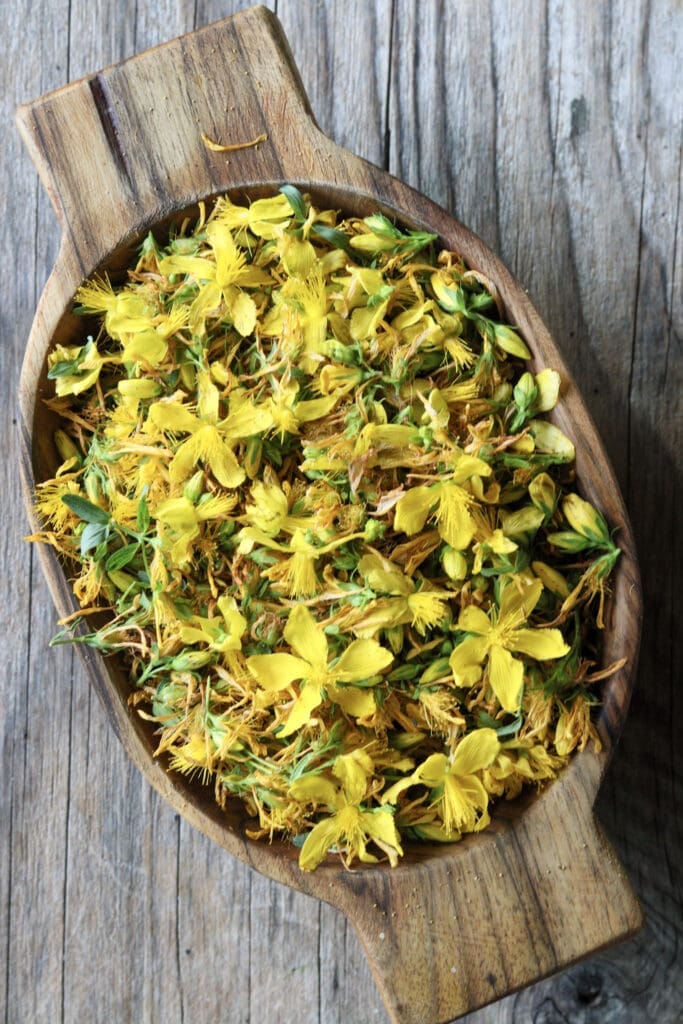
STEP 2: Place the flowers in a glass jar, filling it about three-quarters full (even more for a stronger infusing). Pour in enough oil to completely cover the flowers to the top. Use a spoon or wooden stick to gently press them down, releasing any trapped air bubbles and ensuring the flowers are fully submerged for proper infusion.
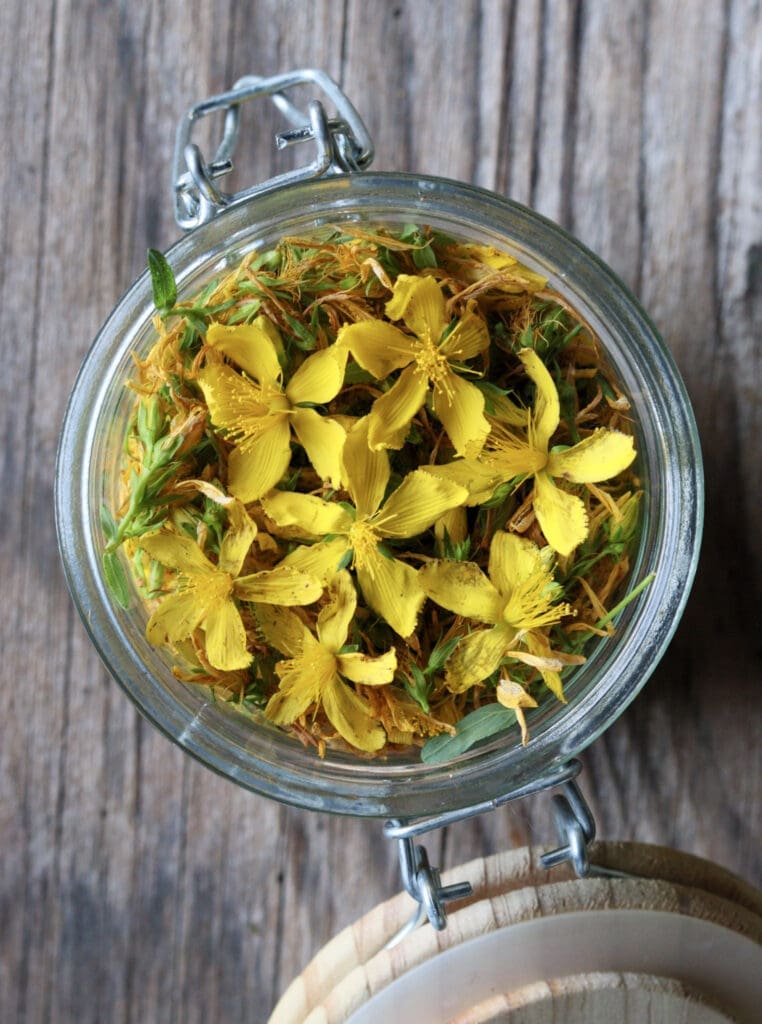
STEP 3: Set the jar in a warm, sunny spot and let it infuse for 3 to 6 weeks. Traditional recipes often call for 40 days, so that’s a good guide to follow. St. John’s Wort, a plant tied to the sun, soaks up sunlight beautifully during this time, and its key healing compound releases best in full sun.
STEP 4: Check the jar every few days and gently stir or shake it to keep the flowers fully submerged. If any flowers start peeking out, press them down with a spoon and top up with more oil as needed. This helps prevent mold and keeps the infusion clean.

STEP 5: Before long, you’ll notice the oil turning a rich ruby red. That deep color comes from hypericin in the flowers and buds—the key compound that gives St. John’s Wort oil its strength. The darker the red, the more potent your oil will be.
After the fourty days, strain out the flowers using a fine strainer or cheesecloth. You can also use medical gauze secured over a bowl with clothespins—it works great.
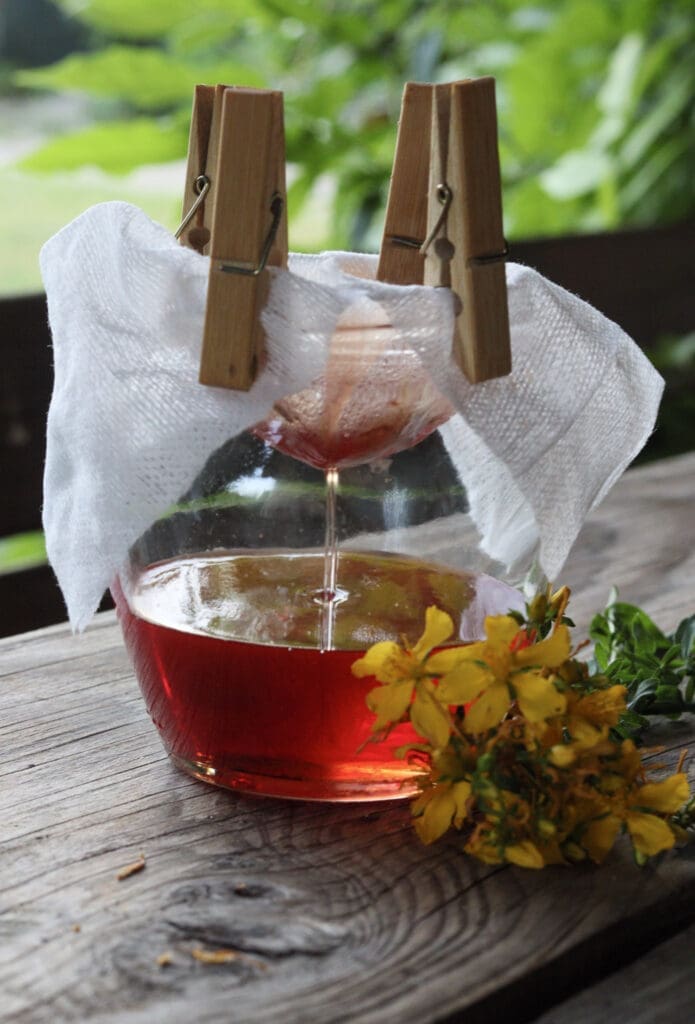
STEP 6: Pour the strained oil into small glass jars or bottles, ideally dark-colored to protect it from light.
You can also pour the oil into handy repurposed cream containers, or turn it into a healing salve by mixing in melted beeswax.
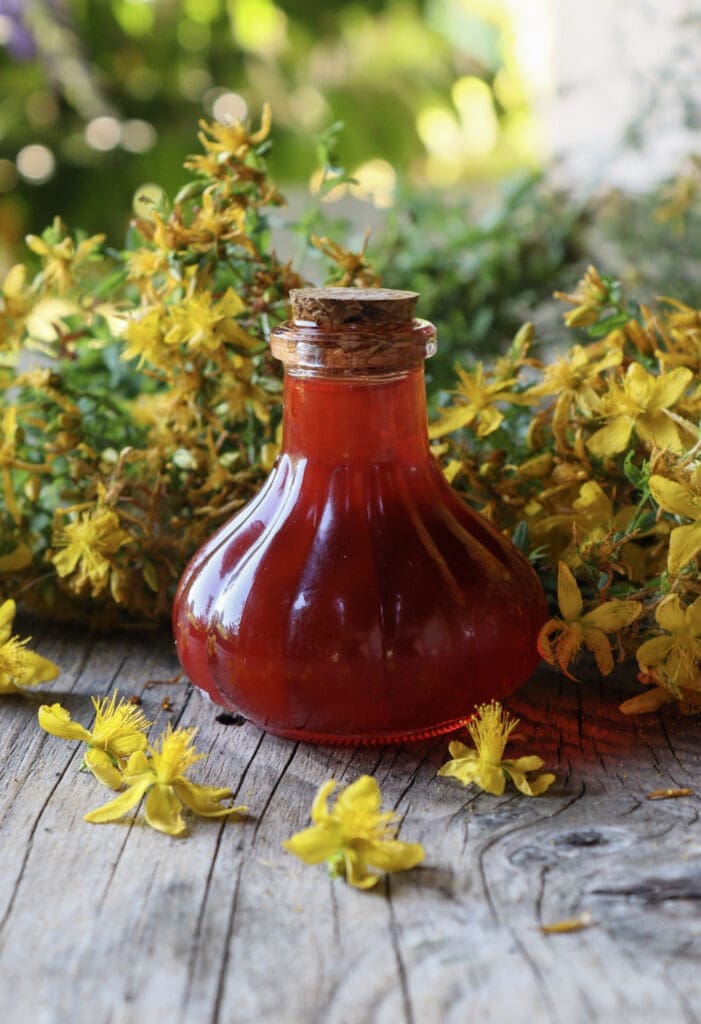
How to store St. John’s Wort infused oil?
Now that you’ve got a fresh batch of ruby-red oil, it’s time to store it properly. We recommend using dark glass bottles or jars because light—especially sunlight and UV rays—can break down the delicate compounds in the oil. This process, known as photo-oxidation, causes the oil to lose its vibrant color, aroma, and healing properties much more rapidly.
Dark glass, such as amber or cobalt blue, helps shield it from light, allowing it to stay fresh, potent, and effective for longer. If you don’t have one of these, you can simply wrap the bottle in aluminum foil.
Don’t forget to label the bottles before storing the oil in a cool, dark place.
If you’ve used a stable carrier oil, your St. John’s Wort oil will easily keep for a whole year, plenty of time until the next harvest. With proper storage in a cool, dark place, it can even stay good for up to two years.
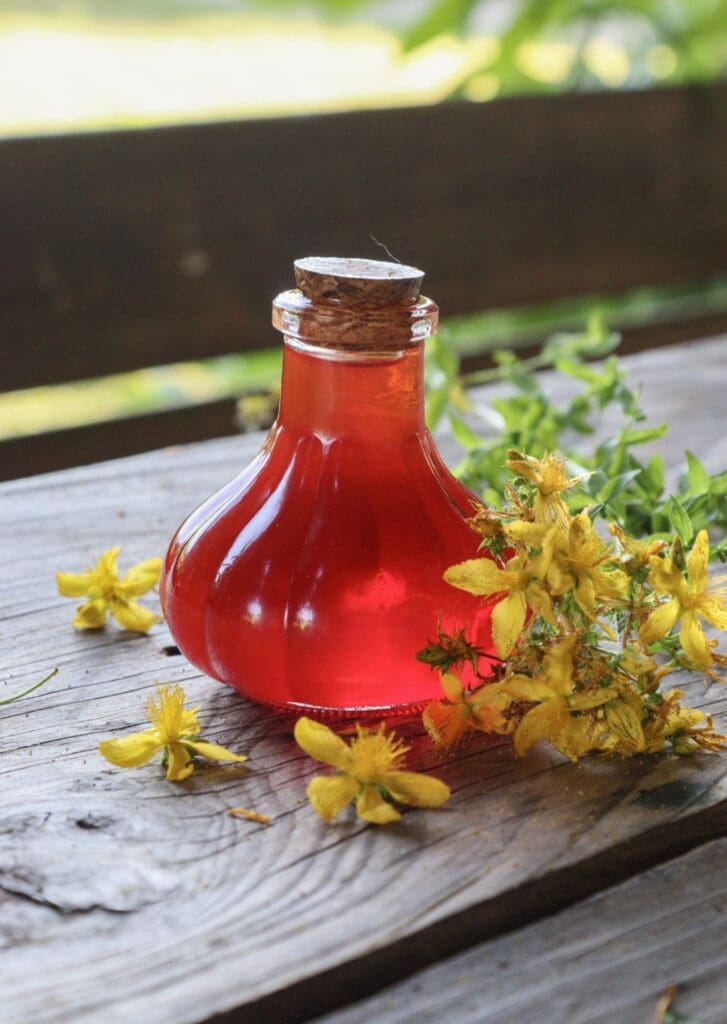
Safety precautions
Photosensitivity – St. John’s Wort oil can increase your skin’s sensitivity to sunlight, thereby increasing the risk of sunburn or irritation. Avoid direct sun exposure after applying it, it’s best to use it in the evening or cover up the part you applied it.
Allergic reactions – Testing it first on a small patch of skin ( the inner side of the wrist is a perfect place for this) is highly recommended.
Don’t use it for deep wounds – This oil is a gentle healer for scrapes, scars, burns and sore spots, but don’t use it for open, gaping cuts.
Pregnancy & breastfeeding – Consult a doctor or midwife before use, especially if applying over large areas.
Drug interactions – If taken internally, St. John’s Wort can interact with medications like antidepressants, birth control, and blood thinners. It’s not recommended to use it after an organ transplant or with drugs for HIV and epilepsy. This isn’t a concern for external use, but please consult a professional if you are unsure.
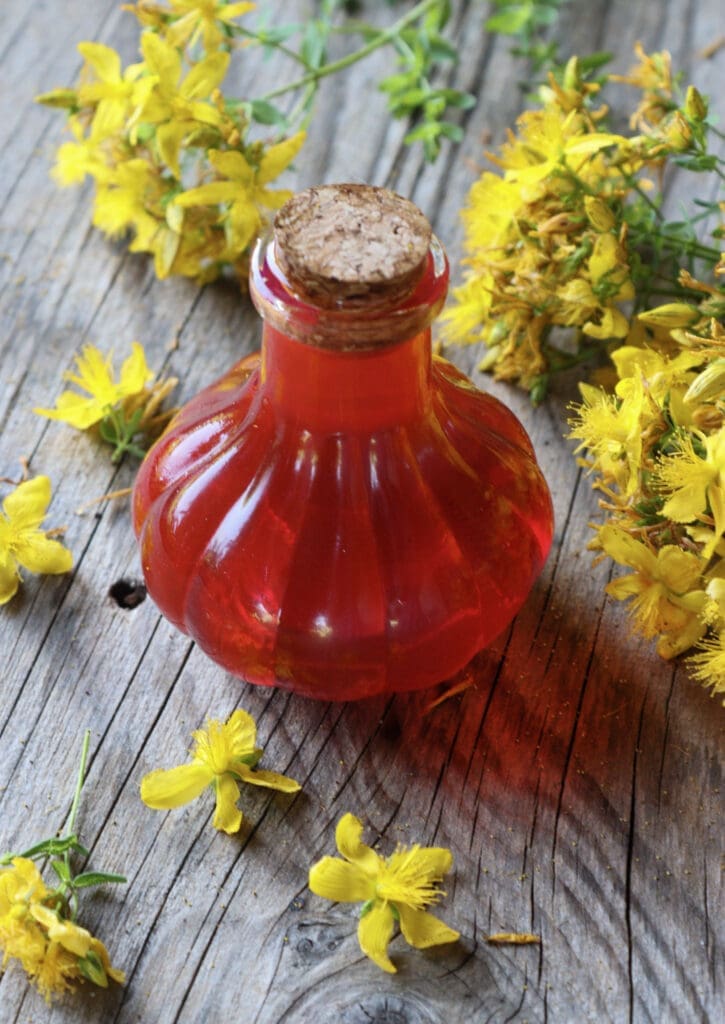
FAQ
To make a St. John’s Wort salve, combine 1 cup of infused oil with 30–40 grams of beeswax. Gently heat the oil in a double boiler, just enough to melt the beeswax. Stir well until fully blended. Remove from heat and pour into sterilized jars or tins. Let it cool completely, then seal. Your healing salve is ready to use!
For cuts, burns, and scrapes, gently massage the oil into clean, dry skin. For muscle or nerve pain, apply it up to three times a day for the best results. For fungal issues, spread a thin layer over the affected area twice daily. Always consult your doctor before using it for serious medical conditions.
You can buy St. John’s Wort oil at most pharmacies, herbal apothecaries, or online. Look for high-quality, cold-infused oils made from fresh flowers in dark glass bottles. Trusted brands include Herb Pharm, Mountain Rose Herbs, and Oshala Farm.
Theoretically yes, but since it’s a very potent remedy, it’s best to consult a healthcare professional (especially about the dosage) before using it internally.
Food nutter’s herbs you might like
How to make helichrysum oil at home
How to Make St. John’s Wort Infused Oil
EQUIPMENT
- 1 glass jar with a lid
- 1 strainer, cheese cloth or clean gauze
- 1 dark or blue storage botlle
- 40 grams beeswax (optional for salve)
INGREDIENTS
- 1 cup St. John's Wort (Hypericum Perforatum) flowers
- 1.5 cup carrier oil (organic olive oil)
INSTRUCTIONS
- Harvest fresh St. John’s Wort flowers. Spread them in a shallow bowl to check for bugs. If needed, leave the bowl in the sun for 30 minutes to let any insects crawl out.
- Fill a glass jar ¾ full with flowers. Pour in cold-pressed olive oil until the flowers are completely covered. Press down with a spoon or wooden stick to release air bubbles and make sure everything is fully submerged.
- Seal the jar and place it in a warm, sunny spot for 4–6 weeks (traditionally 40 days). The sunlight helps draw out the hypericin, giving the oil its rich ruby-red color.
- Check the jar occasionally. Gently stir or shake and top up with more oil if the flowers poke above the surface to prevent mold.
- After 40 days, when the oil has a deep ruby red color, strain it through a cheesecloth or gauze into clean bottles.
- Store in dark glass bottles or jars in a cool, dry place. Properly stored, the oil can last up to 1–2 years. If you wish, process it further into a healing salve by adding melted beeswax.


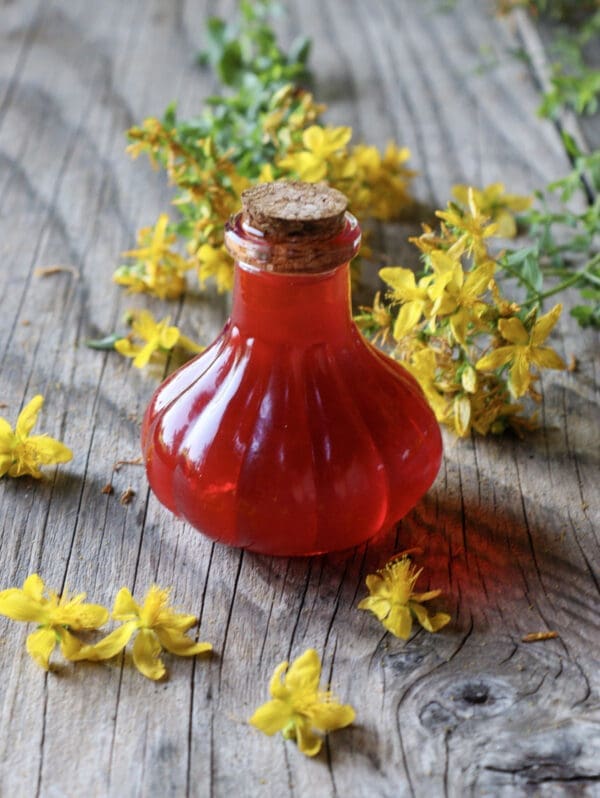
Wow, so interesting! I always look forward to your posts, thanks so much for sharing on craft schooling Sunday!
Thank you Sara, you just made my day 🙂
Mariama, I agree with Sara. I always look forward to your posts as well. I’ve never made this oil, but I love the many uses you mentioned in your post. How wonderful! I’ll be featuring your post tomorrow at The Crazy Little Lovebirds link party. We always enjoy your posts when you share them with us at the link-up. 🙂
Thanks, Steph! This oil really feels like a little treasure to have on hand. I hope you’ll enjoy using it as much as I do. 🙂